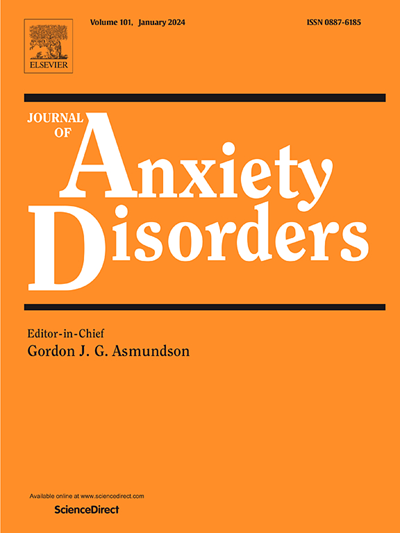社交焦虑症和重度抑郁症患者对积极评价和社会归属感的恐惧
IF 4.5
2区 医学
Q1 PSYCHIATRY
引用次数: 0
摘要
害怕积极评价(FPE)被认为是社交焦虑症(SAD)的一个核心特征;然而,人们对它在人际功能中的作用却知之甚少。我们研究了 FPE 与标准化社会归属范式反应之间的关系,该范式旨在促进与不熟悉的对话伙伴(训练有素的知己)建立积极的社会联系。样本包括患有 SAD(52 人)、重度抑郁障碍(MDD;23 人)、SAD 和 MDD 合并症(36 人)的成年人,以及非精神病对照组(33 人)。参与者完成了对 FPE、情感、安全行为和未来互动愿望的评估。同盟者和观察者对参与者的行为和他们自己对未来互动的渴望进行评分。FPE 在 SAD 和合并症组中升高幅度最大,其次是 MDD 组,然后是非精神病对照组。在全部样本中,FPE 与以下因素相关:自我报告的焦虑和安全行为使用率较高;自我报告的积极情绪和未来互动愿望较低;观察者评定的未来互动愿望和接近行为较低;观察者评定的焦虑行为较高。组内相关性显示,仅有 SAD 组和合并组(与对照组和仅有 MDD 组相比)的相关性较弱;然而,事后调节分析表明,在不同程度的社交焦虑和抑郁严重性中,FPE 与相关结果之间的关系基本保持不变。研究结果强调了 FPE 作为一种跨诊断因素在了解社交焦虑和抑郁的人际功能方面的潜在作用。本文章由计算机程序翻译,如有差异,请以英文原文为准。
Fear of positive evaluation and social affiliation in social anxiety disorder and major depression
Fear of positive evaluation (FPE) is posited as a core feature of social anxiety disorder (SAD); however, little is known about its role in interpersonal functioning. We examined relationships between FPE and responses to a standardized social affiliation paradigm designed to facilitate positive social connection with an unacquainted conversation partner (trained confederate). The sample included adults with SAD (N = 52), major depressive disorder (MDD; N = 23), comorbid SAD and MDD (N = 36), and non-psychiatric controls (N = 33). Participants completed measures assessing FPE, affect, safety behaviors, and desire for future interaction. Confederates and observers rated participant behavior and their own desire for future interaction. FPE was most elevated in the SAD and comorbid groups, followed by the MDD group, and then non-psychiatric controls. In the full sample, FPE was associated with greater self-reported anxiety and safety behavior use, lower self-reported positive affect and desire for future interaction, lower observer-rated desire for future interaction and approach behaviors, and greater observer-rated anxious behaviors. Within-group correlations revealed that associations were weaker in the SAD only and comorbid groups (cf. control and MDD only groups); however, post-hoc moderation analyses indicated that the relationships between FPE and the outcomes of interest largely held across varying levels of social anxiety and depression severity. Findings underscore the potential role of FPE as a transdiagnostic factor relevant to understanding interpersonal functioning in social anxiety and depression.
求助全文
通过发布文献求助,成功后即可免费获取论文全文。
去求助
来源期刊

Journal of Anxiety Disorders
Multiple-
CiteScore
16.60
自引率
2.90%
发文量
95
期刊介绍:
The Journal of Anxiety Disorders is an interdisciplinary journal that publishes research papers on all aspects of anxiety disorders for individuals of all age groups, including children, adolescents, adults, and the elderly. Manuscripts that focus on disorders previously classified as anxiety disorders such as obsessive-compulsive disorder and posttraumatic stress disorder, as well as the new category of illness anxiety disorder, are also within the scope of the journal. The research areas of focus include traditional, behavioral, cognitive, and biological assessment; diagnosis and classification; psychosocial and psychopharmacological treatment; genetics; epidemiology; and prevention. The journal welcomes theoretical and review articles that significantly contribute to current knowledge in the field. It is abstracted and indexed in various databases such as Elsevier, BIOBASE, PubMed/Medline, PsycINFO, BIOSIS Citation Index, BRS Data, Current Contents - Social & Behavioral Sciences, Pascal Francis, Scopus, and Google Scholar.
 求助内容:
求助内容: 应助结果提醒方式:
应助结果提醒方式:


